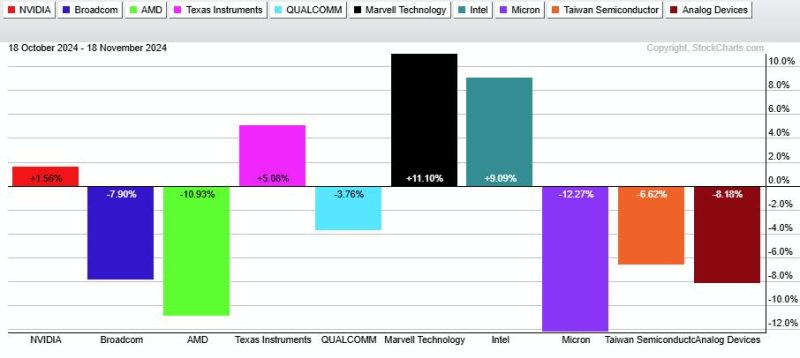In the realm of semiconductor exchange-traded funds (ETFs), two prominent options have emerged as standout choices for investors seeking exposure to this vital sector – the VanEck Vectors Semiconductor ETF (SMH) and the iShares PHLX Semiconductor ETF (SOXX). Both SMH and SOXX provide investors with the opportunity to invest in a diversified portfolio of companies engaged in the semiconductor industry, yet their performance has diverged significantly amid market fluctuations and industry dynamics.
As of the latest data available, SMH has demonstrated stronger resilience and has held up better than SOXX during challenging market conditions. This trend has piqued the interest of investors and market analysts alike as they seek to understand the underlying reasons behind SMH’s outperformance relative to its counterpart.
One key factor contributing to SMH’s robust performance is its composition and weighting of semiconductor stocks. SMH is structured to include a higher concentration of large-cap semiconductor companies, which have generally exhibited more stability and resilience in comparison to small-cap or mid-cap companies. This emphasis on larger companies within the SMH portfolio has provided a cushion against market volatility, thereby helping the ETF to weather turbulent market conditions more effectively.
In contrast, SOXX has a broader exposure across companies of various market capitalizations within the semiconductor industry. While this diversification can offer advantages in terms of potential growth opportunities, it can also expose SOXX to greater volatility and downside risk, particularly during periods of market uncertainty.
Another factor that sets SMH apart from SOXX is its strategic allocation towards companies involved in specific segments of the semiconductor industry that have displayed robust performance. By focusing on high-growth areas such as cloud computing, artificial intelligence, and the Internet of Things (IoT), SMH has benefitted from the strong demand for chips used in these technologies, driving positive returns for the ETF.
Moreover, SMH’s emphasis on companies with solid financial health and competitive positioning has enhanced its ability to navigate challenges within the semiconductor sector. By selecting companies with strong balance sheets, attractive growth prospects, and leading market positions, SMH has positioned itself favorably to capitalize on opportunities for growth and innovation within the semiconductor industry.
In conclusion, the tale of two semiconductor ETFs – SMH and SOXX – offers valuable insights into the nuances of investing in the semiconductor sector. While both ETFs provide investors with exposure to the dynamic and evolving semiconductor industry, SMH’s focus on large-cap companies, strategic allocation towards high-growth segments, and emphasis on strong fundamentals have contributed to its relative outperformance compared to SOXX.
Ultimately, investors evaluating semiconductor ETFs must consider their own investment objectives, risk tolerance, and market outlook when selecting the most suitable option for their portfolios. By understanding the factors driving the performance of ETFs such as SMH and SOXX, investors can make informed decisions to navigate the complexities of the semiconductor market and position themselves for long-term success.



























